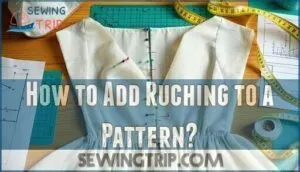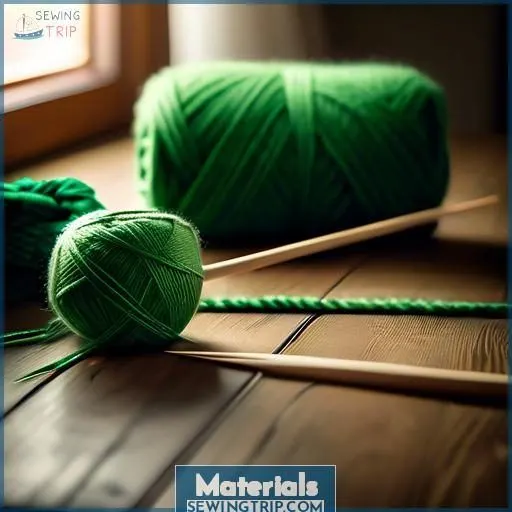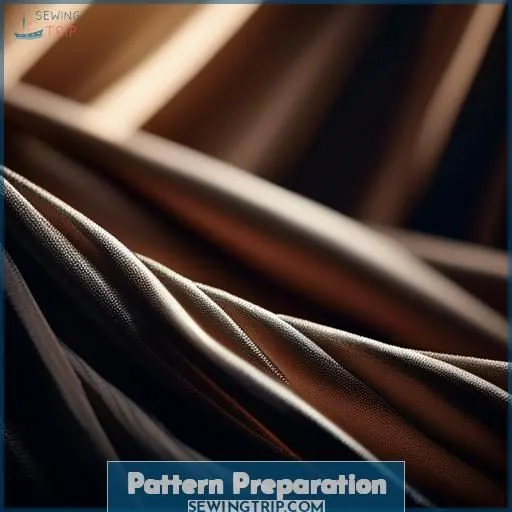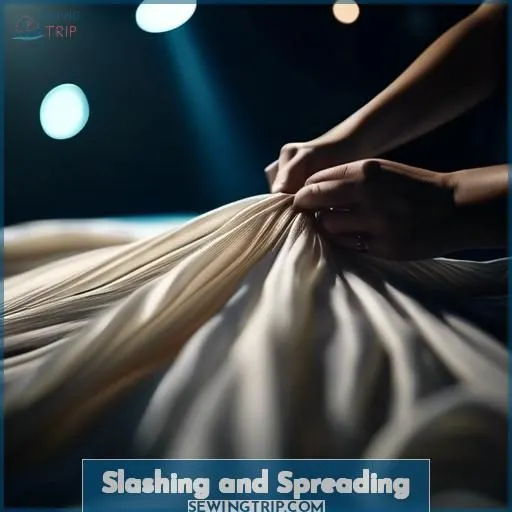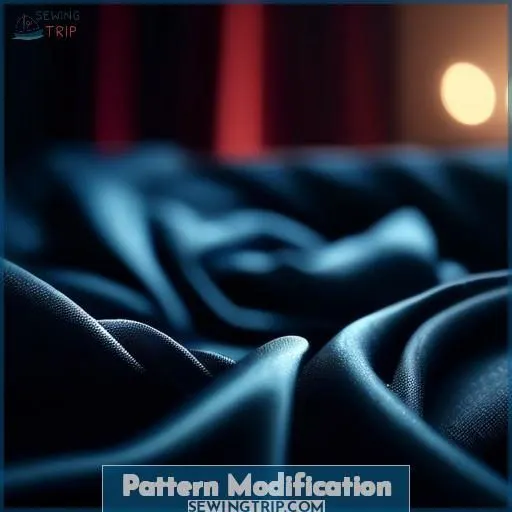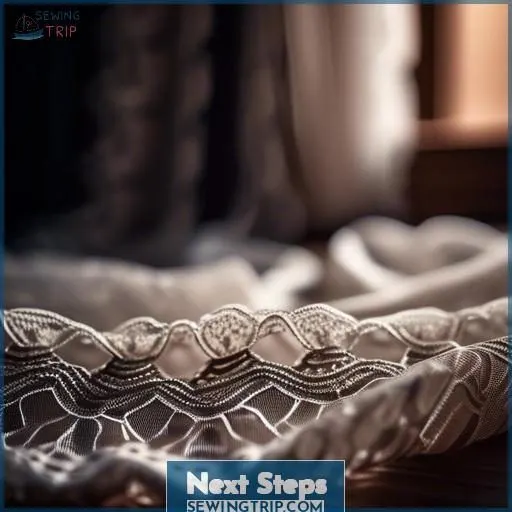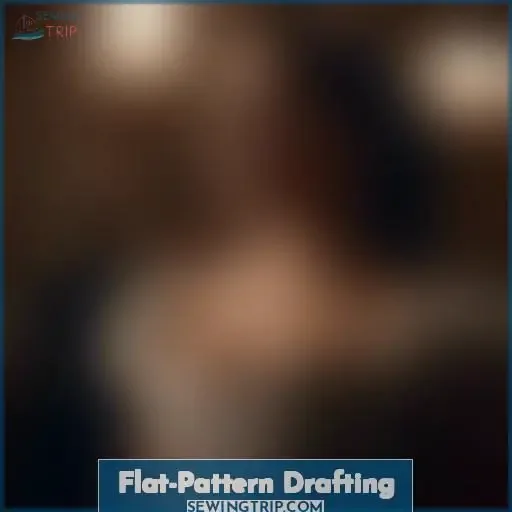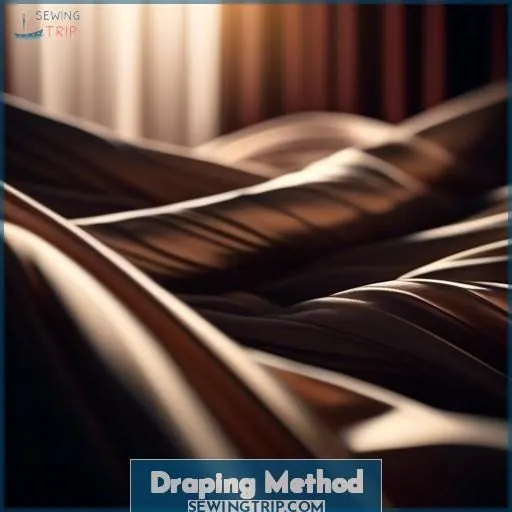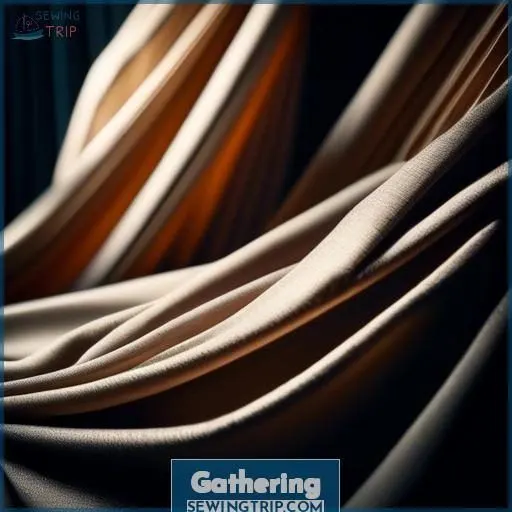This site is supported by our readers. We may earn a commission, at no cost to you, if you purchase through links.
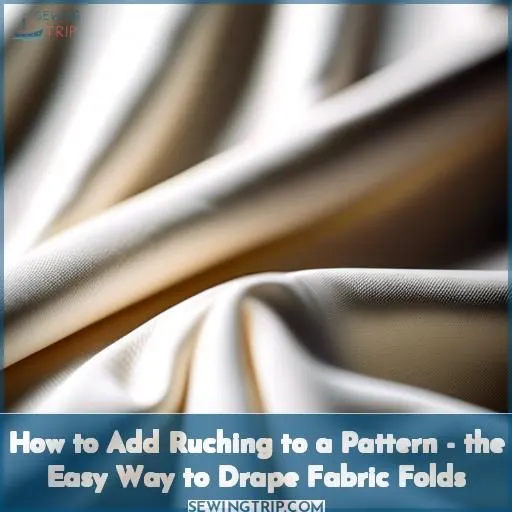
To add ruching to a pattern**, first copy the piece and draw a straight line where you want the ruching.
Next, slash along the line, cutting almost through but leaving 1/16 uncut.
Spread the slashes apart to create the desired fullness.
Tape the spread pattern onto a larger sheet and redraw the outlines.
You can also slash through one side only, spreading that side for one-sided ruching.
Try the draping method too – baste darts and seams, drape extra fabric, and gather stitch outside the seamlines.
Experiment with variations; you’ll soon master how to add ruching to patterns elegantly.
Table Of Contents
Key Takeaways
- Slashing and spreading the pattern is a crucial step in adding ruching, which involves cutting along the line where you want the ruching to occur and leaving a small amount of fabric uncut.
- Experimenting with different draping methods, such as bias or pleated drapes, can help you achieve the desired look for your ruching.
- When gathering the fabric, it’s essential to keep the gathers parallel to the floor and pull horizontally to keep them taut.
- Using the right type of paper for pattern making, such as manila pattern paper or heavier weight tracing paper, is essential for creating ruching.
How to Add Ruching to a Pattern?
To add ruching to a pattern, you can use the slash-and-spread method.
This involves drawing a straight line on your copied pattern piece where you want the ruching to be. Measure that line, and then multiply it by 1.5 or 2.
Draw straight slash lines from the ruching line, cut each line, and then tape or glue the pieces back together, spreading them evenly along the ruching line.
Smooth out the new curved lines and add a 1/4 inch seam allowance to the new ruching line.
The new ruched pattern will look different from your original pattern and will need to be cut into two separate pieces from your fabric.
Materials
To add ruching to a pattern, you’ll need:
A large sheet of paper
Tape
A ruler
A curve ruler (optional)
Pattern paper
Pattern weights
A clear ruler
Scissors
A pencil
Overlay fabric
A mannequin
Contrast thread
Pins
Having these materials at your disposal will ensure you have everything necessary to prepare the pattern, slash and spread the ruching lines, modify the pattern, and explore both flat-pattern drafting and draping methods.
Large Sheet of Paper
Regarding pattern creation, the chosen paper type can markedly influence the outcome. Here are essential factors to weigh when selecting paper for your project:
- Paper size: Verify that the paper is ample in size to accommodate your pattern components. Patterns may vary substantially in size, so choose paper that’s at least 48 inches wide to avoid joining multiple sheets.
- Paper quality: Seek high-grade paper that’s robust and durable. This will mitigate tearing, especially when transferring patterns or making adjustments. Manila pattern paper is commonly used for its strength and pliability.
- Paper texture: A smooth texture is generally preferred for pattern making, as it enables precise tracing and marking. Avoid papers with a coarse or bumpy texture, as this can hinder the accuracy of your patterns.
- Paper weight: The weight of the paper can impact its transparency and ease of use. Thin papers, such as tracing paper, may be more susceptible to tearing, while thicker papers, such as manila pattern paper, are more durable and less prone to tearing.
- Paper grain: The grain of the paper refers to the direction in which the fibers run. For pattern making, it’s crucial to use paper with a consistent grain, as this will help guarantee that your patterns are precise and uniform.
- Paper opacity: Select paper with high opacity, as this will prevent ink or pencil marks from being visible on the other side. This is particularly important when tracing or transferring patterns.
- Paper transparency: Transparency is vital for tracing patterns, as it allows you to see through the paper to the underlying pattern. While some papers are designed to be highly transparent, such as tracing paper, others may be less transparent, which can make tracing more challenging.
Regarding ruching, you’ll also need to weigh the type of paper you use for the pattern pieces. Search for papers that are sufficiently strong to withstand the manipulation required for creating ruching, such as manila pattern paper or a heavier weight tracing paper.
Tape
Tape is a versatile and essential tool when it involves pattern modification and sewing. It can be used to secure pattern pieces to a large sheet of paper, hold them in place while making alterations, and even serve as a temporary adhesive for gathering fabric. Here are some key points about using tape to add ruching to a pattern:
Tape for Pattern Pieces: When modifying patterns, you can use tape to secure pattern pieces to a large sheet of paper, such as Swedish Tracing Paper, to keep them in place while making alterations. This helps prevent the pattern pieces from shifting or moving during the modification process.
Tape for Gathering: When gathering fabric for ruching, you can use tape to hold the folded fabric in place while you sew. This can be particularly useful when working with lightweight or delicate fabrics that might be difficult to handle without slipping.
Tape for Aligning: Clear fashion tape can be used to temporarily hold fabric pieces together while aligning them for sewing. This can be helpful when working with multiple layers or when trying to match up seams or patterns.
Tape for Pressing: Some types of tape, such as Embroidery Perfection Tape, can be pressed with an iron to create a permanent bond with the fabric. This can be useful when you want to secure a pattern piece or fabric piece in place without the need for pins or clips.
Tape for Pattern Modification: When modifying a pattern to create ruching, you may need to cut the pattern into two separate pieces. Tape can be used to hold the pieces together while you adjust the pattern and make any necessary alterations.
Tape for Sewing: Some types of tape, such as seam binding tape, can be used to reinforce seams and provide a neat finish. This can be particularly useful when working with lightweight or delicate fabrics that mightn’t hold up well to repeated handling or wear.
Remember to choose the right type of tape for your project. For paper patterns, you might prefer a tape that can be pressed with an iron, such as Embroidery Perfection Tape. For fabric, you might prefer a clear fashion tape that can be easily repositioned or a double-sided adhesive tape that provides a temporary bond. Always follow the manufacturer’s instructions for using the tape and confirm that it works well with the materials you use.
Ruler
A ruler is an essential tool for pattern making, providing the precision needed to create accurate measurements and lines. It’s important to choose the appropriate ruler for your project, depending on the pattern’s shape and size. For example, a French curve ruler is useful for creating curved lines, such as armholes and necklines, as it has a curved edge that follows the natural shape of the body. On the other hand, a straight edge ruler is necessary for drawing straight lines and squared lines, which are required for creating patterns like pants and skirts.
When working with paper patterns, a clear ruler can be particularly helpful, as it allows you to see the lines of the pattern and make quick adjustments. Additionally, a transparent ruler with grid lines can be useful when drafting patterns, as it helps to measure and mark various aspects of the pattern with ease.
For those working on a budget, there are affordable options available. For instance, a basic straight edge ruler is a necessity for sewing and patternmaking, and it can be found at fabric stores or online for around $6-$8. Similarly, a mini L-square ruler, which is a smaller version of the larger 14 x 24 L-square, can be purchased for around $6.50 for an 8 x 12 size.
Curve Ruler (optional)
A curve ruler masters bias drapes and pleated ruching, turning fabric manipulation into a canvas of creativity.
Pattern Paper
Pattern paper is a vital part of adding ruching to a pattern. It’s important to pick the right pattern paper for accurate pattern drafting. Here are three key things to keep in mind when choosing pattern paper:
- Pattern Size: The paper should be big enough for your pattern pieces. Many sewists like using paper that’s at least 36 inches wide because it lets most pattern pieces fit without needing to tape them together.
- Paper Quality: The paper should be strong and able to handle being slashed, spread, and taped. Kraft paper, butcher paper, and manila pattern paper are popular choices because they’re durable and can take pattern adjustments.
- Storage Options: Think about how you’ll store your pattern paper after use. Clear file boxes, file cabinets, and even repurposed suitcases or magazine files are all options. Keeping your pattern paper organized and easy to find can save you time and stress later.
Pattern Weights
Pattern Weights are essential for sewing projects, especially when working with delicate pattern pieces and lighter fabrics.
They serve a similar function as paperweights but are usually made from fabric or other soft textures.
Pattern weights are used to hold down pattern pieces on top of your fabric while you mark or cut.
They can also be used to hold long or heavy fabric pieces on your table while you work with them.
To use pattern weights, simply place them on one corner or side of your pattern piece, ensuring they’re heavy enough to hold the piece in place.
Adjust as needed and remove them once you have finished cutting.
Pattern weights are available in various shapes and sizes, including triangles, squares, and rectangles.
They can be made from a range of materials such as fabric, sand, walnut shells, or metal shot.
Clear Ruler
A clear ruler is an essential tool for pattern making and sewing. It allows you to see your project under the ruler for accurate positioning and marking. It has a zero center scale to measure equally left and right from the center starting point.
This ruler is perfect for assisting in increasing or decreasing the size of a pattern. With bold measurement lines and a clear acrylic body, you can easily see your material and patterns through the ruler, ensuring accurate measurement marks.
The Sailrite Clear Acrylic Ruler is a multiuse must-have for every DIYer. It has a length of 24 inches and width of 6 inches, making it ideal for cutting long strips of fabric right off the bolt.
Scissors
Scissors are a crucial tool in the realm of sewing and fabric manipulation. They come in diverse sizes and forms, yet the most prevalent kind employed for sewing is the diminutive, incisive pair that effortlessly slices through layers of fabric. Here are four ways scissors play a pivotal role in the art of ruching:
- Cutting the Template: Scissors are used to excise the template pieces, encompassing the base layer and the draped fabric, into the requisite shapes for ruching.
- Trimming Excess Material: Post-gathering, scissors are deployed to shave off the extraneous material to conform to the base incision line, guaranteeing a trim and orderly outcome.
- Removing Lateral Seams: When manipulating the draped fabric, scissors are used to eradicate the lateral seams from the underbodice, facilitating effortless handling and ruching.
- Excising Drapery: Scissors are used to excise the drapery, which constitutes the additional fabric employed to engender the ruching effect, with seam allowances incorporated.
Remember to employ sharp scissors and maintain their cleanliness to secure optimal outcomes when working with fabric.
Pencil
After snipping with scissors, grab your pencil; it’s time to draw, measure, and perfect.
| Pencil Use | Tool Needed | Purpose |
|---|---|---|
| Drawing | Pencil Ruler | Straight Lines |
| Curving | Pencil Curve Ruler | Smooth Curves |
| Tracing | Pencil Pattern Paper | Transfer Patterns |
| Anchoring | Pencil Pattern Weights | Secure Paper |
| Measuring | Pencil Clear Ruler | Precision |
Overlay Fabric
Choose overlay fabric wisely; its drape placement and gathering techniques will revolutionize your pattern alteration journey.
Mannequin
To create a ruching pattern, you’ll need a mannequin to position the fabric and secure it in place. This allows you to visualize how the fabric will fall and drape, which is essential for achieving the desired look. Position the mannequin according to the pattern you’re working on, ensuring that the measurements align with the design specifications.
When securing the fabric to the mannequin, follow these steps:
- Begin by pinning the base layer of the pattern to the mannequin, making sure that the seams and darts are in the correct position.
- Next, pin the overlay fabric to the base layer, ensuring that the fabric’s grain is aligned correctly.
- Gather the fabric as you pin, keeping the gathers parallel to the floor and pulling horizontally to keep them taut.
- Adjust the gathers until you’re satisfied with the drape and the overall appearance of the pattern.
Once you’re happy with the draping, remove the pins and mark the seam lines with chalk. Then, cut out the drape with seam allowances, remove the side seams from the underbodice, and lay the drape on top of the base pattern, pinning and re-stitching the seams as needed.
Remember to experiment with different draping techniques and fabrics to find the most suitable look for your design.
Contrast Thread
In the art of sewing, contrasting thread has a vital role in the method of adding ruching to a design. Contrasting thread is applied for holding together when making patterns manually, such as for reverse applique or when including ruching to a dress. It’s strong enough to separate the fibers of the fabrics, creating the required perforations in the background fabric, which is integral for the ruching technique.
To add ruching to a design, you’ll need to hand baste the contrasting thread along the direction of the overlay fabric. This will assist you in gathering the fabric as you pin it to the seam allowance of the base layer. Remember to maintain the gathers aligned with the floor and pull across to keep them tight. Adjust the gathers until you’re satisfied with the appearance.
Once you have gathered the fabric, you can trim the excess overlay to correspond with the base cut line. Tailor tack the overlay to the base at notches, and add tacks if needed to correspond with the base and overlay.
To create the design and sew, remove the overlay from the mannequin and use it to cut the second side. Trace the overlay to create the design, baste two lines of stitches on the gathered sides, and then pin the overlays to the base and sew with a long machine stitch.
When working with contrasting thread, it’s essential to remember that it can also be applied for hand quilting. It’s resistant to tearing and abrasion, and won’t curl, making it a versatile option for various sewing endeavors.
Pins
Pins are essential for positioning, tension, and gathering your draped fabric. Here’s how to use them effectively:
- Pin the drape to the bodice: Place pins along the seam allowances, ensuring they align with the base layer.
- Pin the overlay to the base: Use pins to secure the overlay to the base layer, keeping gathers parallel to the floor.
- Adjust gathers: Pull horizontally on the gathers to keep them taut and adjust as needed.
- Remove pins: Once you’re satisfied with the gathers, remove the pins and proceed to the next step.
Pattern Preparation
To prepare your pattern for ruching, start by making a copy of the pattern piece you want to add ruching to. Then, draw a straight line on that pattern piece to indicate where the ruching will be placed.
Copy the Pattern Piece to Be Ruched
To add ruching to a pattern, you’ll first need to duplicate the pattern piece you want to ruch.
This can be done by tracing the pattern onto pattern paper or by using an overlay fabric.
Make sure the pattern location is accurate, and the line placement and orientation are correct.
The number of slashes you make will depend on the desired amount of ruching.
Typically, you’ll make slashes parallel to the grainline, following the line of the original pattern piece.
The accuracy of your cuts is essential, as any inaccuracies can affect the final result.
Draw a Straight Line Where Ruching Will Be Placed
Draw a straight line where ruching will be placed.
To determine the length of the line, multiply the initial measurement by a ratio increase.
For example, if you want to increase the length by 50%, multiply the initial measurement by 1.5.
If you prefer curved shapes, use a curve ruler to guide your line.
Remember to think about the fabric tension and the desired effect of the ruching.
Slashing and Spreading
On your pattern piece, draw straight slash lines perpendicular to the marked line where you want the ruching to go. Carefully cut along each slash line, leaving about 1/16 inch uncut at the ruching line so the pattern doesn’t fall apart completely.
Draw Straight Slash Lines From the Ruching Line
Now, let’s embark on the art of slashing and spreading. Envision your pattern as a treasure map, where each slash is a pathway leading to the concealed riches of enhanced volume.
Your objective? To sketch direct slash lines from the ruching line. Consider the slash angle as the compass direction, steering the expansion of your garment.
The slash length is your step, dictating how striking or refined the metamorphosis will be. With the tape method as your companion, you’ll connect these new domains, employing the smoothing technique to ensure the fabric’s terrain transitions harmoniously.
Let’s commence this expedition!
Cut Each Line, Leaving 1/16 Uncut
To guarantee the structure of slash lines is accurate, leave 1/16 uncut.
This uncut allowance is essential for the exactness of your ruching.
Incomplete cuts can lead to discrepancies and impact the overall appearance of your garment.
While alternative methods may suggest cutting all the way through, the 1/16 uncut allowance provides a level of control and precision that’s vital for a professional finish.
By following this step, you’ll be on your way to creating a beautiful, well-fitted garment with flawless ruching.
Pattern Modification
Now that you’ve slashed and spread your pattern, it’s time to make some modifications.
You’ll need to draft alterations for the ruching, which involves customizing the pattern to accommodate the embellishment.
This may involve adding or removing fabric, adjusting seam lines, or even creating new pattern pieces.
Remember to be creative and experiment with different techniques to achieve the desired effect.
Once you’re satisfied with your drafts, you’ll move on to the next steps.
Next Steps
After preparing the pattern and spreading the fullness, it’s time to move on to the next steps. These include draping the bodice, gathering the fabric, and creating the pattern.
- Draping the Bodice: Start by cutting and basting bodice darts and side seams. Press the fabric, try it on, and pin the back seam closed. Drape extra fabric on the grain, and use safety pins or tape to attach the drape to the bodice. Gather stitch the drape just outside the seamlines.
- Gathering the Fabric: Mark the seam lines with chalk, remove the pins, and lift the drape away. Cut out the drape with seam allowances, remove the side seams from the underbodice, and lay the drape on top of the bodice. Pin and re-stitch the seams.
- Creating the Pattern: Remove the overlay from the mannequin and use it to cut the second side of the pattern. Trace the overlay to create the pattern, baste two rows of stitches on the gathered sides, and pin the overlays to the base. Sew with a long machine stitch.
Remember to practice these techniques on cheaper fabric before using expensive fashion fabric to avoid any mistakes. Experiment with different draping methods, such as bias or pleated drapes, to find what works best for your project.
Flat-Pattern Drafting
To create ruching using flat-pattern drafting, slash through the bodice pattern where you want the ruching, then spread the slashed area to add fullness. Tape the slashed pattern to a larger piece of tissue paper, spread the ruched side while leaving the un-ruched side intact, then redraw the outlines to create the new pattern shape.
Slash Bodice Pattern and Spread Fullness
To slash and spread your bodice pattern, start by drawing straight slash lines from the ruching line.
Then, cut each line, leaving 1/16 inch uncut.
Next, place the slashed pattern on a large sheet of paper and tape or glue the first piece.
Measure out 1/2 inch and tape or glue the next piece.
Smooth out the new curved lines.
Add a 1/4 inch seam allowance to the ruching line.
Tape to Larger Tissue and Redraw Outlines
Once you’ve spread your pattern’s fullness, it’s time to get down to brass tacks:
- Secure the slashed pattern onto larger tissue.
- Make sure alignment for accuracy.
- Carefully redraw outlines, capturing new contours.
- Trim excess tissue, leaving a clean edge.
Precision now means perfection later!
Slash Through Pattern for One-sided Ruching
To add one-sided ruching to a pattern, you’ll first need to slash through the pattern for the ruching effect.
This involves cutting the pattern along the line where you want the ruching to occur, leaving a small amount of fabric uncut.
Once you’ve slashed the pattern, you can spread the ruched side and leave the unruched side intact.
This will create an asymmetrical ruching effect on the bodice, which can be achieved through various methods such as pleating, gathering, or using an overlay fabric.
Spread Ruched Side and Leave Un-ruched Side Intact
To spread the ruched side and leave the un-ruched side intact, follow these steps:
- Place the slashed pattern on a large sheet of paper.
- Tape or glue the first piece, measure out 1/2, and tape or glue the next piece.
- Smooth out the new curved lines and add a 1/4 seam allowance to the ruching line.
- The original cut-on-fold pattern will now be cut into two separate pieces.
- The new pattern will have a different shape than the original.
Draping Method
You’ll start by cutting and basting the bodice darts and side seams. Once pressed, try the bodice on the dress form and pin the back seam closed. Drape the extra fabric on grain over the bodice, and gather stitch the drape just outside the seamlines to create the ruched effect.
Cut and Baste Bodice Darts and Side Seams
To begin, gather your materials: bodice darts, side seams, baste contrast thread, pin to seam allowance, and gather as you pin. You’ll use these materials to baste the bodice darts and side seams. Start by sewing the darts on the base layer and pinning them to the mannequin. Then, cut the overlay fabric wider and twice as long as the base.
Next, hand baste contrast thread along the grain of the overlay. Pin the overlay to the seam allowance of the base layer, gathering the fabric as you pin. Keep the gathers parallel to the floor and pull horizontally to keep them taut. Adjust the gathers until you’re satisfied with the fit.
Once you have adjusted the gathers, trim the excess overlay to match the base cut line. Tailor tack the overlay to the base at notches and add tacks if needed to match the base and overlay. Carefully remove the overlay from the mannequin and use it to cut the second side of the pattern.
To create the pattern, trace the overlay onto a new sheet of pattern paper. Baste two rows of stitches on the gathered sides of the overlay. Pin the overlays to the base and sew with a long machine stitch. Press the gathered fabric to set the stitches and create a smooth appearance.
Remember to experiment with different types of drapes, such as bias or pleated drapes, to find the look that best suits your design. Enjoy the process of adding ruching to your pattern and creating a unique, custom garment.
Press, Try On, and Pin Back Seam Closed
After basting those bodice darts and side seams, it’s showtime. Press your creation, slip it on, and cinch that back seam tight. This isn’t just about fit; it’s mannequin preparation for the magic of overlay gathering. Adjust those gathers, pull horizontally, and tack the overlay. Mastery’s in the tweaking!
Drape Extra Fabric on Grain
To drape extra fabric on the grain for ruching, follow these steps:
- Choose the right fabric: Select a fabric with good draping properties and stability. Natural fibers like silk or linen, or synthetic blends, can work well for ruching.
- Prepare the fabric: Press the fabric to remove any wrinkles or creases. This will help you achieve a smooth drape.
- Pin the fabric: Pin the fabric along the grain line where you want the ruching to be. Make sure the pins are evenly spaced and parallel to the grain.
- Gather the fabric: Gather the fabric by pulling the pins in the direction of the center of the ruching area. This will create the desired fullness and drape.
- Adjust the tension: Experiment with the tension of the gathers by adjusting the distance between the pins. A tighter tension will create more volume, while a looser tension will result in a more relaxed drape.
- Check the placement: Make sure the ruching is evenly distributed along the grain line. Adjust the pins as needed to achieve the desired look.
- Remove the pins: Once you’re satisfied with the drape, carefully remove the pins. Be sure not to pull the fabric too hard, as this could cause stretching or damage.
Gather Stitch Drape Just Outside Seamlines
To gather stitch the drape just outside the seamlines, follow these steps:
- Mark the seam lines with chalk.
- Remove pins and lift the drape away from the mannequin.
- Cut out the drape with seam allowances.
- Remove side seams from the underbodice.
Gathering
After draping the overlay fabric onto the base pattern, it’s time to finalize the gathered sections. First, mark the seam lines with chalk on the draped overlay, then carefully remove the pins and lift the draped fabric away from the base pattern. Next, cut along the chalk seam lines, adding seam allowances, to create the separate gathered overlay pieces.
Mark Seam Lines With Chalk
Mark seam lines with chalk for precision and flawlessness. This straightforward step guarantees that your ruching will be symmetrically dispersed and aligned, bestowing your garment with a refined appearance.
Remove Pins and Lift Drape Away
- Remove pins and lift drape away
- Keep gathers parallel to the floor
- Pull horizontally to keep gathers taut
- Adjust gathers until satisfied
Cut Out Drape With Seam Allowances
Once you’ve got your drape gathering looking sharp, it’s time to cut. Keep those seam allowances generous; you’re not just trimming the fat, you’re crafting the perfect overlay placement. Two rows of gathering stitches will do the trick.
| Step | Action |
|---|---|
| 1 | Pin drape securely |
| 2 | Mark seam allowances |
| 3 | Cut with precision |
| 4 | Trim excess fabric |
| 5 | Check overlay fit |
Remove Side Seams From Underbodice
To remove side seams from the underbodice, follow these steps:
- Carefully lift the drape away from the mannequin, ensuring the overlay fabric remains in its original position.
- Mark the seam lines with chalk for reference.
- Cut out the drape with seam allowances, matching the cut line of the base pattern.
- Remove side seams from the underbodice, preserving the original shape of the pattern.
- Lay the drape on top of the base pattern, aligning the seam lines and pinning in place.
- Re-stitch the seams, using a thread choice that complements the fabric tension and gather spacing.
Lay Drape on Top, Pin, and Re-stitch Seams
Lay the drape on top of the bodice, aligning the edges with the raw edges of the bodice. Pin the drape in place, making sure the gathers are evenly distributed. Re-stitch the seams of the drape, using a gathering stitch just outside the original seamlines. This will create the desired ruching effect on the bodice.
Tips
You can experiment with bias or pleated drapes for a different take on ruching. This allows you to play with various fabric grains and folds, creating unique textures and shapes on your garments. Have fun exploring creative methods, and don’t hesitate to share successful techniques with others in the sewing community – collaboration often yields innovative ideas.
Experiment With Bias or Pleated Drapes
To make your draping project more creative, you can experiment with different types of drapes. Here are three ideas to explore:
- Bias Drapes: Bias drapes are cut at a 45-degree angle to the straight grain of the fabric, which gives them a softer, more fluid appearance. They can be used to create a unique, flowing effect that adds movement and texture to your design.
- Pleated Drapes: Pleated drapes are created by gathering the fabric into folds, typically in a V-shaped pattern. This creates a controlled, full look that can be used to add volume and depth to your draping project.
- Innovative Drapes: You can also experiment with unconventional draping techniques, such as using different fabric textures or incorporating unique folds and shapes. This can help you create a truly one-of-a-kind look that showcases your creativity and skill.
Have Fun and Share Successful Methods
You’ve mastered the art of adding ruching to your patterns! Now it’s time to have some fun and share your successes. Here are some creative ideas for your next project:
- Fabric experimentation: Try out different types of fabric for your ruching. Silk, satin, or lace can add a luxurious touch to your garment.
- Pattern innovation: Don’t limit yourself to just bodices. You can add ruching to skirts, pants, or even jackets for a unique twist.
- Alternative embellishments: Instead of traditional ruching, try pleats, gathers, or even fringe for a different look.
- Personal style: Make your ruching truly yours by adding your own personal touch. A unique color scheme, pattern, or texture can make your garment stand out.
Frequently Asked Questions (FAQs)
Can ruching be added to knit fabric garments?
Contrasting with rigid fabrics, you’ll find knits offer unparalleled ruching potential. Their inherent stretchiness allows for effortless gathering, creating divine texture. So go ahead, ruche that knit – it’ll hug every curve divinely.
How does fabric choice affect the ruching outcome?
You’ll get the best ruching on lightweight fabrics with good drape – silk, rayon, even stretchy knits. Heavier fabrics may need extra slashing or pleating to achieve that ruched look. But don’t be afraid to experiment! That’s where the real fun lies.
Are there alternative methods to create ruching without sewing?
You can create ruching without sewing by strategically pinning, gathering, and knotting fabric. Experimenting with different techniques like fabric origami or smocking produces unique texture and dimension to your garments – a creative twist on traditional ruching methods.
How do you adjust ruching for different body types?
To adjust ruching for different bodies, you’ll want to play with the spacing and depth of the gathers. For curvier figures, tighter ruching flatters; for straighter shapes, looser gathers add shape. And don’t be afraid to asymmetrically place ruching for an edgy look!
What are the common mistakes to avoid when adding ruching?
Like Icarus flying too close to the sun, common ruching pitfalls await the overeager seamstress: uneven gathering, visible basting threads, and losing the grain’s integrity. Avoid these snares through careful pinning, carefully concealed stitches, and respecting fabric’s natural drape.
Conclusion
Experimenting and practicing various ruching techniques on patterns will unquestionably elevate your design skills.
Mastering how to add ruching to a pattern through slashing, spreading, draping, or gathering not only enhances garment aesthetics but also showcases your creativity.
Persist in exploring fresh approaches, and you’ll soon create alluring, fashionable pieces that exquisitely incorporate fabric folds.
Embrace the art of ruching wholeheartedly, and let your designs speak volumes.

